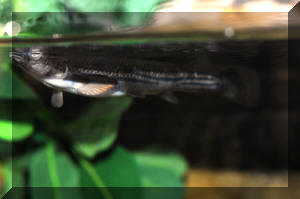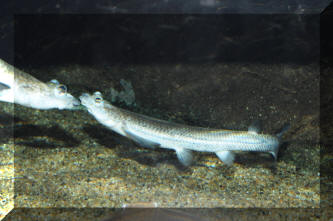Family Anablepidae, three genera, thirteen species, fresh,
brackish and marine. The monotypic Oxyzygonectes is oviparous, the
other genera/species are "one-sided" livebearers.
Mmm, talk about odd ball fishes... Being able to see and make sense
out of four different optical fields of view simultaneously? Being
livebearers that can/do only mate on one side, right-"handed"
males with left-"handed" females and vice versa? Umm, the
Anableps can live on land, moist for extended periods of time... tend
to travel in schools... The family is known in the sciences as
"the four-eyes, one-sided livebearers and white-eye"... I
rest my case.
Distribution:
Southern Mexico to the end of South America.
Subfamily Anablepinae, Genus Anableps, three species. Benefit
from some salt in their environment, live foods, frequent water
changes. Used in eye research. Will eat small fishes.
|
Anableps anableps (Linnaeus 1758), the Large
Scale Foureyes. South American; Trinidad, Venezuela to the Amazon
Delta. To a foot in length. Found principally in freshwater, but
does move out to the mangroves, on mud flats where it feeds on
algae, insects. Cond.s: temp. 24-28 C. Most commonly encountered
species. 3-5 narrow dark stripes on sides. |
male and female shown above
|
|
Bigger PIX:
The images in this table are linked to
large (desktop size) copies. Click on "framed" images to
go to the larger size.
|
|

%20MD.JPG)

|
|
Anableps dowi Gill 1861, the Pacific Four
Eye. Pacific; Southwestern Mexico to Nicaragua. To almost nine
inches in length. Brackish to marine. Temp. 24-28 C. Upper body is
dark brown, below is a yellow band, with brown under this.
|
|
|
Anableps microlepis Muller & Troschel
1844, Foureyes. South American; Trinidad, Venezuela to the Amazon
Delta. To a foot in length. Has two narrow bands bordering yellow
area in-between along body.
|
|
Subfamily Jenynsiinae
|
Jenynsia spp.
Livebearers
|
|
|
Oxyzygonectes
To 12 cm. Egglayer
|
|
|
Excerpted From:
So
you think livebearers are boring? There's more to livebearers than guppies. Neale Monks
looks at some of the interesting and unusual livebearers
available to aquarists by Neale
Monks
The Anablepidae
Starting our review of the livebearers
alphabetically, the four-eyed fishes of the genus Anableps
certainly qualify as being decidedly un-boring fish. In
fact, it would be hard to find more interesting aquarium fish.
Their most celebrated features are their eyes, which are each
divided into two lobes, one for seeing above the waterline, and
the other below. This specialisation presumably allows them to
hunt for food and avoid predators at the same time, and these
fish are certainly nervous, jumpy fish that take a long time to
settle into aquarium life.
The other famous oddity is that these
fish aren't just male or female; they're
'right-handed' or 'left-handed' as well. Females
have a covering, called a foricula, over the genital opening that
is hinged on either the left or the right hand side of the
opening. If the foricula is hinged on the right, the genital
opening is only clear on the left, and vice versa. Males
have a gonopodium, a modified anal fin, that delivers sperm to
the female, and again, it either bends to the left or to the
right. A male with a gonopodium that bends to the right can only
mate with a female that has its genital opening open on the left,
and left-handed males can only mate with females that are open to
the right.
In terms of aquarium care, four-eyed
fish are quite demanding. The first issue is size: these are big
fish, getting to around 25-30 cm in length. Females are usually a
bit bigger than the males, but if you want to breed these fish,
you're going to need to keep at least half a dozen specimens
just to make sure you get compatible males and females.
Consequently, a big aquarium with plenty of filtration is
essential. Complicating things somewhat is the need these fish
have for 'resting' places. In the wild, these fish beach
themselves on sandbanks, but in aquaria, large, smooth stones or
flat pieces of slate will work perfectly well. Arrange these so
that they form a ledge a just far enough under the waterline that
the fish can rest with just their eyes protruding. Finally, these
are brackish water fish, and do not do well when kept in
completely fresh water. The exact saltiness of the water
isn't critical, but a specific gravity between 1.005 and
1.010 will do nicely.
Despite being livebearers, breeding
these fish isn't especially easy. As with some of the other
oddball livebearers, the tricky bit is making sure the female
doesn't miscarry. Providing optimal water conditions and a
stress-free environment is half of the battle here, but keeping
her in good conditions by providing plenty of live and frozen
foods is just as important. The baby fish are born after a
gestation period of about three months, and they are about 5 cm
in length, easily big enough to small brine shrimp, daphnia,
bloodworms, and other small foods. The parents aren't
especially cannibalistic, but removing them to a separate
maturing tank is a good idea, if only so that you can ensure that
the baby fish get plenty of food.
|
Bibliography/Further Reading:
Jackson, Lee. Anableps, the four-eyed fish. Thanks to a thicker lens
on top, Anableps vision above the water is as clear as it is below. TFH
8/87.
Klee, Albert J. 1968. Anableps, the four-eyed fish. The Aquarium
10/68.
Neal, Tom. 1998. Those fabulous Four-Eyes! TFH 3/98.
Taylor, Edward C. 1980. Anableps. The amphibious livebearer, pt.s
1,2 FAMA 11,12/80.
West, Patricia J. & Charles Lydeard. 1995. The fabulous
four-eyed fish. TFH 7/95.
|
|

